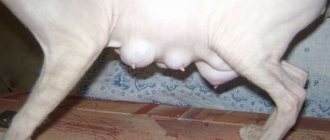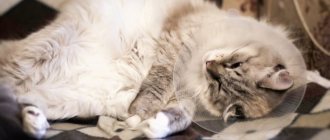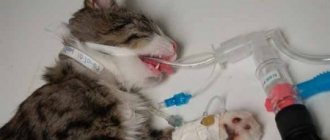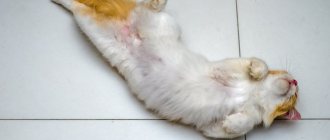Will my cat go into heat after spaying? The most common question asked by Murok owners before deciding to undergo genital removal surgery. Usually the answer is no, it won't. But why does a cat sometimes walk after sterilization?
If you do not take into account the poor quality work of the surgeon, then there are plenty of other reasons for this. This happens very, very rarely and in most cases is due to health problems not related to the operation. Let's find out in the article why a cat walks after sterilization.
What is estrus
Estrus is a period during which a cat experiences hormonal, physiological and behavioral changes. They are associated with the female’s readiness to mate and bear offspring.
The period of estrus is accompanied by severe stress for the animal. The cat becomes restless, loses its appetite, constantly screams and looks for a male. It is during this period that cats are most prone to escape. Due to the effects of hormones, they are not able to adequately assess the danger, and therefore can even jump out of an open window from a high floor.
The period of estrus often becomes a real test for both the cat and its owner. It is worth noting that empty heats (if the cat has not mated and become pregnant) are very dangerous for the health of the animal. They often lead to inflammation of the ovaries, pyometra (a deadly disease), mammary gland cancer, and other disorders in the animal’s body.
That is why veterinarians often advise sterilizing all cats that do not have breeding value and do not participate in breeding. This will protect both the owner’s nerves and the health of his pet, and no more stray kittens will appear on the street.
What happens during and after sterilization?
The veterinarian makes a small puncture in the abdominal area. During the operation, the ovaries themselves or the ovaries and the uterus are removed. All blood vessels, arteries and veins are ligated, and after the operation the abdominal area will be closed with a cosmetic suture.
With classical sterilization of cats, after 7 days, the sutures are removed, and with the cosmetic method they will dissolve on their own. During recovery from classical sterilization, your furry friend will have to wear a special collar to prevent her from licking and damaging the stitches.
First heat
Typically, a cat's first heat begins between 6 and 10 months of age. Sometimes a four-month-old kitten may go into heat, which is considered a deviation from the norm. In this case, the animal should be shown to a doctor. In some cases, estrus does not begin even after one and a half years of age. This is a signal that something is wrong with the cat's health.
Factors that influence when a cat goes into her first heat:
- Heredity.
- Animal size.
- The presence of a mature cat in the house.
- Health status.
- Does the cat have access to the outside? Outdoor cats often mature earlier. Since the average lifespan of street cats is shorter than that of domestic cats, they try to leave offspring as early as possible.
- Breed.
It is worth noting that a cat’s first estrus may be blurred, without obvious symptoms. The owner may not even know that his pet has already formed and is quite ready for mating. However, even during an asymptomatic period, a cat can become pregnant. This is why keeping kittens of different sexes older than six months together is somewhat risky.
Cat puberty occurs earlier than physical maturation. This is why you should not mate a female during her first heat: this can lead to a difficult pregnancy, problems during childbirth, and behavioral disorders (it happens that mothers who are too young do not want to take care of their kittens).
Often, breeders mate cats for the first time at the age of one and a half years, when the female has already gone through 2-3 heats. At this age, the cat is already old enough, and the risks of pregnancy are minimized.
Stages
Sexual arousal in a cat occurs in several stages:
- proestrus;
- estrus;
- metestrus;
- anestrus.
Estrus in a cat, or scientifically known as estrus, is a physiological process necessary for further procreation. Sexual desire in cats is divided into four categories: preliminary, estrus, metestrus, and end of the cycle.
The preliminary period - proestrus is characterized by an increase in the size of the follicles located in the ovaries. They contain a mature egg. During proestrus, there is an increased production of the female hormone estrogen.
The cat at this stage is not ready to mate and become fertilized, but the owner may notice changes in the behavior of the pet. The animal becomes more demanding, wants more attention, appetite decreases, and it can damage furniture. There is pronounced swelling in the area of the external genitalia, and mucous discharge appears. The duration of this stage is from 2 to 4 days. After it comes the estrus itself.
Estrus, or true estrus, is the stage most suitable for fertilization of an egg by a sperm. This period is characterized by increased cat activity. She screams invitingly and waits for the male, behaves strangely indoors, crouching to the floor, raising her butt, can swing it from side to side, and bends her tail.
Depending on the character of the animal, signs of true estrus may vary. Thus, more temperamental females become aggressive and excessively noisy, but calmer females will not be so eager to leave the house, but will still annoy the owner with their behavior. The duration of true estrus in cats varies from person to person, but on average ranges from a week to 14 days.
The third period of estrus in a cat is metestrus, which is a decline in sexual desire, the behavior of the pet changes dramatically. Instead of affection and screams, aggression towards males occurs. An unfertilized female becomes calmer, and in the case of fertilization, the animal prepares for the upcoming pregnancy.
In some cases, metestrus without fertilization turns into a pathological state such as false pregnancy. This phenomenon is extremely similar to normal pregnancy - the female builds a nest for the “future” offspring, the mammary glands swell, and colostrum is released.
This condition is dangerous for the animal, as it can provoke a serious hormonal imbalance in the body and requires corrective treatment under the supervision of a veterinarian.
The fourth period is anestrus, characterized by the end of the sexual heat cycle. The cat becomes calm and balanced. Under normal conditions, estrus in a cat is a physiological process and does not require any outside intervention from the owner in the form of injections and tablets. It is necessary to show maximum attention to the animal, in no case scolding, and also without locking it in the room. The use of physical force is prohibited, as it can provoke serious psychological trauma in the animal.
We suggest you read: Suprastin for cats: can the medicine be given, dosage for allergies and during estrus, contraindications
Symptoms and features of estrus
The onset of estrus is often accompanied by a change in the animal's behavior. During this period, the cat has practically no control over its behavior; it is under the complete power of instincts. This is why even the most well-mannered, but unsterilized, cats during the period of estrus often begin to go to the toilet in a place other than the litter tray. They mark their territory with their scent, thus attracting males.
You might be interested in: A cat was bitten by a tick: how to help your pet?
The cat's egestive cycle is divided into several phases, which have their own symptoms:
- Precursor or proestrus. Hormonal changes begin to occur in the animal's body. A cat may become too affectionate and constantly ask for attention from its owner. At the same time, she is not yet ready for mating, and therefore does not allow cats to approach her and can react quite aggressively to them.
- Estrus or estrus. Swelling of the genital organs can be observed, and light, clear discharge is possible. The cat often licks itself under its tail. She behaves restlessly, rubbing herself against furniture, walls and her owner’s legs. The cat can press itself to the floor and raise its tail, inviting the male to mate. Often this period is accompanied by screams that do not stop day or night. The cat's appetite decreases. During this period, the animal may lose weight.
- Afterflow or metestrus. The cat no longer allows males to approach her. Often during this period she may already be pregnant. Sometimes after estrus in cats a state of false pregnancy occurs. If pregnancy does not occur, the hormonal levels gradually return to normal, and sexual desire subsides.
- Interestrus or Anestrus. This is a period of rest that occurs between heats. The animal is completely calm, all symptoms of estrus are completely absent. The cat shows no interest in cats.
In some cases, symptoms of estrus remain unexpressed. The owners may even be pleased with this course of events, because the behavior of the pet during a special period does not change at all. However, the absence of symptoms of estrus may indicate a malfunction of the animal's body. In addition, even cats with relatively calm heats are still at risk. They are susceptible to various diseases of the reproductive system.
If a cat is involved in breeding, but her estrus is mild, contact with a sexually mature cat can often change the situation. After this, the symptoms of estrus should become more pronounced. In some situations, the veterinarian may prescribe hormonal medications to the animal, which will help establish a normal estrus cycle.
Why should you sterilize your cat?
- Neutered cats live longer. Numerous studies and works of scientists in the field of veterinary medicine have long shown and proven the influence and positive impact of sterilization on the health and life expectancy of animals. This is why the procedure is so popular in Western countries.
- Neutering cats keeps them healthy. Indeed, sterilized cats get sick less, this is explained by better health, due to the lack of stress and the cat’s expenditure of strength and energy during binges, especially if they are frequent.
- Prevention of diseases on the female side. Your cat, once spayed, will be protected from diseases such as pyometra and hydrometra, ovarian or uterine cysts and mammary tumors. Some of these diseases are seriously dangerous and, if urgent help is not provided, are completely fatal.
- Sterilized cats are much calmer, more affectionate, and have a more docile character, unlike their non-sterilized female cats. It’s all due to hormones, elevated levels of which even lead to excessive aggressiveness in cats as they age.
- Calm at home. Some cats, especially in the spring, try to “break free”, and some run away to meet the cat and may simply get lost. Sterilizing cats can solve this problem too.
- The cat will not give birth. Although few people are currently interested in the issue of regulating the number of stray animals, and apartment residents’ cats do not see cats or the street at all, for residents of private houses the issue of offspring and kittens is very relevant. If a cat goes outside and is not sterilized, there will definitely be kittens. Therefore, if you don’t want to become the owner or mistress of an entire cat family, you know what to do.
After sterilizing the cat before the first spree, there will be no uncomfortable behavior associated with it. This may include loud screams, a constant desire to escape from the apartment, and marking the territory with urine.
At the moment, gentle sterilization of cats is the most modern, safe, non-traumatic and reliable way to rid a cat of binge drinking while maintaining her health and comfort.
Her number one desire at this time is to find a cat to mate with, so she will want to run outside. It is sterilization that will help solve the problem with any of the listed cases. The likelihood of developing a breast tumor or cancer of the uterus and ovaries will be reduced, including the chance of developing pyometra, which is fatal without timely surgery.
Frequency and duration of estrus
The body of each animal is individual, therefore it is impossible to determine the exact timing and frequency of estrus in an individual cat. However, there are approximate dates that the sexual cycle of an animal should normally correspond to. A cat's heat can last from 6 to 10 days. Some cats can be in the period of active sexual hunting for up to 20 days. The duration of estrus is influenced by many factors. In young animals, heat can last only a couple of days. With age, the cycle will return to normal. Also, the duration of estrus depends on the weight of the animal, breed, living conditions, and state of health.
The frequency of estrus depends on the following factors:
- Health status.
- Breed. In Siamese and Persian breeds, estrus occurs every three weeks, but in British and Scottish breeds, the resting period can be up to 3 months.
- Conditions of detention.
- How quality is the food?
- Season. In winter, cats begin a long period of rest, but in the spring the frequency of estrus resumes. However, in animals that live in warm rooms around the clock, the frequency of estrus does not depend on the time of year. They are often ready to mate all year round.
- Heredity.
- Excess weight or excessive thinness.
- Stress. If the cat is in a stressful environment, estrus may stop altogether.
- Age of the cat. The older she is, the less often estrus occurs.
You might be interested in: What causes a cat's eyes to fester?
If a cat becomes pregnant during estrus, the next heat will begin only three months after the kittens are born. Although there are cases when a cat becomes ready to reproduce immediately after giving birth. It also happens that a false pregnancy may occur as a result of estrus. All symptoms indicate that the cat is expecting kittens, and the cat herself is sure of this, and therefore she begins to actively prepare for future motherhood. In this case, the cycle may also be slightly disrupted.
About care after sterilization.
After sterilization using a gentle method, unlike the classical one, cats do not need to remove sutures, injections or bandages. This makes life much easier for both cats and their owners, freeing them from the additional stress of visiting the veterinarian and any manipulations. Our care recommendations are more about how to ensure your cat's comfort in the immediate days after surgery.
Comfortable place to relax. The cat will need some sleep to gain strength. It would be good to prepare a bed for her. It needs to be done on the floor, in a place where there are no drafts. Lay a blanket or blanket on the floor; it is better to roll them up in several layers, and put a baby absorbent diaper (available at any pharmacy) or a towel on top.
First feeding. When 4 hours have passed after sterilization, you can offer the cat water and food. If she doesn’t want to eat right away, that’s normal.
It is better to start with wet ready-made food (bags or canned food); if she eats natural products, offer meat or fish, depending on her taste preferences. You need to be patient, give the cat some time to recover, avoid games and heavy loads for the first week, and then everything will return to normal.
How to calm a cat during heat
First of all, the owner should immediately decide whether his pet will participate in breeding. It should be noted that childbirth is a rather complex process. Some owners believe that childbirth will only benefit their pet. But this is far from true. Pregnancy consumes a lot of resources, it wears out the body. In addition, pregnancy is accompanied by various risks, which may well lead to the death of the mother and cubs. This is why you should not breed animals that have no breeding value. Pregnancy will not bring any benefit to the cat itself, and outbred kittens often end up on the street.
If the cat will not participate in breeding, it should be sterilized. Moreover, it is advisable to do this before the age of one. At this age, the animal’s body has not yet encountered hormonal storms. The uterus is small in size, it can be easily removed, and the animal will quickly recover after the operation. But it is worth noting that surgery done too early can lead to problems with urination in the animal. Therefore, it is advisable to sterilize a cat at the age of 6-7 months.
If the cat does not participate in breeding, or it cannot be sterilized for some reason, then there are other ways to help the pet. During this period, the cat really needs affection and attention. The pet should be petted more often and treated affectionately.
Even if the cat does not behave quite adequately, you should be patient. You shouldn't scold her. The cat cannot control some of its impulses, and it is not her fault. Taking your anger out on an animal, beating it, scolding it is not worth it. This can lead to mental disorders, due to which the cat may begin to behave inappropriately not only during periods of heat.
There are medications that can calm the animal. They are often made from various plant components. Such medications act as a sedative, but they do not stop the estrus itself. You should consult your doctor before giving your cat any medications. Some of them are not at all harmless - they can cause drowsiness and seriously affect the behavior and health of the animal.
There are also hormonal drugs. They are just capable of completely stopping estrus. But using them is strictly not recommended. Such medications lead to various diseases of the cat’s reproductive system. Hormonal drugs are good for the owner, since due to their effect the animal does not go into sexual heat. But these medications have a negative effect on the health of the animal, and therefore they should be purchased only as prescribed by a doctor.
Preparing a cat for sterilization.
Sterilization of cats is carried out under anesthesia and the preparation here is the same as for any anesthesia. You should not give your cat anything to eat 10-12 hours before or anything to drink 2 hours before visiting the veterinarian.
We advise you to plan the procedure in the morning; it will be easier for your cat to withstand a hungry diet at night.
Such preparation is quite sufficient for a good effect of anesthesia and easy and quick awakening and recovery after surgery.
A sterilized cat is in heat
It happens that even sterilized cats continue their estrus cycle. There may be several reasons for this:
- The operation was performed incorrectly.
- The ovaries were not removed, or ovarian tissue remained in the abdominal cavity.
- Sex hormones are secreted by a tumor, which can be located in the uterus, mammary glands, adrenal gland, or pituitary gland.
- The adrenal glands and pituitary gland continue to produce sex hormones even after the ovaries are removed.
You might be interested in: A cat has black in the corners of its mouth: what could it be?
Often, the attenuation of sexual behavior does not occur immediately after sterilization. Sex hormones still circulate in the cat’s body, which lead to behavioral abnormalities. Sexual behavior subsides approximately 2-8 weeks after surgery. But in some animals it can last much longer. This is especially true for cats that have been spayed during estrus.
The age of the cat also affects how quickly the animal's behavior is corrected. The more heats a cat has experienced, the older she is, the greater the chance that sex hormones will begin to be actively secreted not only by the ovaries, but also by other glands. This means that late sterilization of a cat may not be effective in correcting the animal’s behavior. The cat will not be able to become pregnant after the operation, but signs of sexual heat will continue to be observed in the future.
The essence of the sterilization method
The term "castration" is usually applied to cats. However, there are 2 types of surgical interventions for cats:
- Sterilization. Removal of both ovaries (oophorectomy).
- Castration. Excision of all genital organs - the uterus with fallopian tubes and ovaries (hysterovariectomy).
The operation is performed on the animal using various methods, including classical.
It is more prudent to carry out castration, given that the remaining uterus may in the future become the object of inflammation, neoplasms, and a purulent reservoir. The choice of type of operation is influenced by the age of the animal. If the cat has not yet reached puberty and has not given birth, then sterilization is preferred. It is advisable to castrate a mature individual who has undergone childbirth. There is a classical method of performing the operation and a laparoscopic one. Various localizations of incisions on the animal’s abdomen are practiced. The duration of the operation is on average 30-45 minutes.











